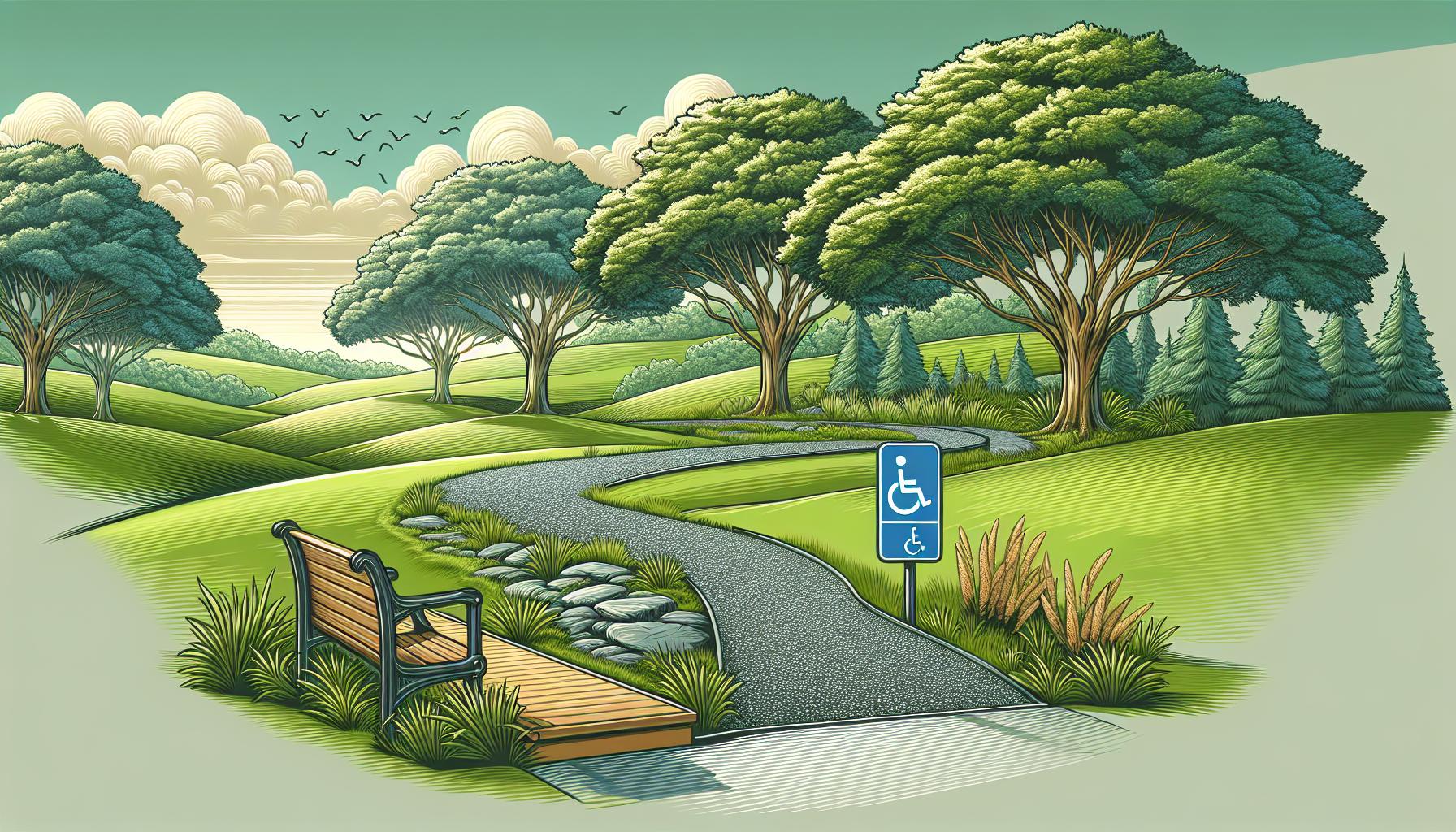Exploring the great outdoors should be an experience everyone can enjoy, and Santa Rosa is stepping up to the plate. With its breathtaking landscapes and serene nature spots, it’s a haven for those of us looking for wheelchair-accessible trails.
I’ve been on a mission to find the best spots where wheels are just as welcome as feet. It’s all about inclusivity and the sheer joy of experiencing nature without barriers. So, let’s dive into some of Santa Rosa’s most accessible trails that promise adventure and accessibility for all.
Overview of Wheelchair Accessibility in Santa Rosa
When I first embarked on my journey to discover the most accessible nature trails in Santa Rosa for wheelchairs, I wasn’t sure what to expect. Santa Rosa’s commitment to inclusivity, however, quickly became apparent. The city’s efforts to make the great outdoors accessible to everyone, including those of us in wheelchairs, are commendable. As I delved deeper, it became clear that Santa Rosa isn’t just about creating pathways; it’s about reshaping the way we experience nature.
One of the key highlights I discovered is the variety of trails available. Whether you’re in the mood for a serene lakeside pathway or a trail that offers panoramic views of the rolling hills, Santa Rosa has something for everyone. The city’s parks and recreation department has worked tirelessly to ensure these trails are not only accessible but also enjoyable, with well-maintained paths and clear signage.
Accessibility features that stood out for me included wide and firm pathways suitable for different wheelchair types, gentle slopes, and resting areas strategically placed to offer a moment of repose and enjoyment of nature’s beauty. Moreover, many trails are equipped with accessible parking and restroom facilities, making day trips seamless and worry-free.
To offer a better understanding, here’s a quick look at some key data on Santa Rosa’s accessible nature trails:
| Trail Name | Length (Miles) | Surface Type | Rest Areas | Accessible Facilities |
|---|---|---|---|---|
| Spring Lake Park | 2.3 | Paved | 3 | Yes |
| Trione-Annadel State Park | 5.5 | Gravel | Multiple | Limited |
| Santa Rosa Creek Trail | 1.2 | Paved | 2 | Yes |
Santa Rosa’s approach to enhancing wheelchair accessibility goes beyond just physical modifications to the trails. Efforts to engage the community through accessible events and nature programs have played a significant role in fostering a culture of inclusivity. Participation in such events has not only allowed individuals in wheelchairs to explore nature but has also educated the broader community on the importance of accessibility in outdoor spaces.
Spring Lake Regional Park Trail

Exploring Santa Rosa’s accessible nature trails led me to the beautiful Spring Lake Regional Park, a place where everyone, regardless of mobility, can immerse themselves in nature. My visit here was a reminder of how inclusivity can extend to outdoor experiences, offering serene views and a chance to connect with nature in a way that’s accommodating to all.
One of the standout features of Spring Lake Regional Park Trail is its fully paved path that loops around the lake. This design ensures that individuals in wheelchairs can navigate the trail without facing the common outdoor barriers of uneven terrain or steep slopes. The park’s dedication to accessibility is evident in the smooth, wide pathways that accommodate both wheelchairs and strollers, making it a family-friendly destination.
The trail spans approximately 3.0 miles, winding through scenic landscapes that showcase the natural beauty of Santa Rosa. The gentle grade of the trail is especially noteworthy; it has a maximum slope that’s carefully measured to prevent strain, ensuring a relaxed journey for everyone. Here are some specifics:
| Feature | Detail |
|---|---|
| Length | 3.0 miles |
| Path Type | Fully Paved |
| Max Slope | Designed for easy wheelchair navigation |
| Amenities | Benches, restrooms, picnic areas |
What’s more, strategically placed benches offer rest stops with captivating views, inviting visitors to pause and soak in the surroundings. These resting spots are a thoughtful addition, acknowledging that everyone’s endurance levels are different.
Accessibility goes beyond just the physical structure of the trails. Spring Lake Regional Park is proactive in their signage, which is clear and informative, providing guidance and information to all park-goers. This, combined with the accessible restrooms and picnic areas, ensures a worry-free outdoor experience.
My journey through Spring Lake highlighted how thoughtful considerations and adaptations in our natural spaces can foster a sense of belonging and joy for people with mobility challenges. The park isn’t just a place to visit; it’s a vivid example of how outdoor recreation can be inclusive, offering memorable experiences to everyone. The beauty of Santa Rosa’s landscapes, coupled with the commitment to accessibility, makes Spring Lake Regional Park Trail a must-visit for those who love nature but require considerate accommodations to fully enjoy it.
Howarth Park Trail
Continuing my exploration of accessible nature trails in Santa Rosa, I discovered the hidden gem that is Howarth Park Trail. Nestled within the larger Howarth Park, this trail offers a unique blend of natural beauty and accessibility that’s hard to find elsewhere.
Unlike the fully paved path of Spring Lake Regional Park Trail, Howarth Park Trail includes a mix of surfaces. Although most of it is paved and smooth, there are sections that are packed dirt. This slight variation doesn’t detract from its accessibility; instead, it adds a bit of diversity to the terrain, suitable for those adventurous spirits seeking a bit more of a natural feel while still being navigable in a wheelchair.
The trail itself is about 2.3 miles long and winds its way through lush greenery, offering breathtaking views of the park’s lake and the surrounding landscapes. What I particularly love about it is not just its aesthetic appeal but also its practical features:
- Benches at various points for resting
- Accessible restrooms ensuring comfort for all visitors
- Picnic areas that are perfect for gatherings
These amenities make the Howarth Park Trail not just a path but a destination where visitors can spend hours enjoying the outdoors with family and friends.
One notable aspect of Howarth Park is its commitment to inclusivity. Though it has diverse terrain, the park has ensured that the main attractions, such as the children’s playground and the boating dock, are accessible. This deliberate design choice means that everyone, regardless of mobility, can enjoy what the park has to offer.
The signage around the park deserves a special mention. It’s clear and informative, guiding visitors through the different sections of the trail and park, ensuring that navigating through the area is straightforward for everyone.
In terms of natural beauty and inclusivity, Howarth Park Trail stands out as a beacon in Santa Rosa. Its well-thought-out design and facilities cater to visitors who require wheelchair accessibility, yet it doesn’t compromise on the quality of the outdoor experience. Engaging with nature, finding tranquility amidst greenery, and experiencing the joy of outdoor recreation are all within reach at Howarth Park Trail. My journey through Santa Rosa’s accessible nature trails brought me here, and the experience has been nothing less than fulfilling.
Taylor Mountain Regional Park Trail
After my exhilarating experiences at Spring Lake and Howarth Park, I felt an undeniable urge to keep exploring the accessible nature trails that Santa Rosa generously offers. This time, my adventurous spirit led me to the well-known Taylor Mountain Regional Park Trail. Unlike the previous locations, Taylor Mountain presents a unique challenge and reward system that’s perfectly tailored for those who crave a bit more from their outdoor excursions.
Taylor Mountain Regional Park stands proud with over 1,100 acres of lush landscape and towering vistas. It’s a haven for hikers, bikers, and, importantly, those of us seeking wheelchair-accessible trails. The park features several trails, but the Western Trail caught my attention due to its renowned accessibility features and scenic beauty. Before I delve deeper into my journey, let’s glance at some key features of the park’s trails designed for accessibility:
| Trail Name | Length (miles) | Surface Type |
|---|---|---|
| Western Trail | 1.2 | Paved/Gravel |
| Eastern Ridge | 0.8 | Mostly Paved |
| Northern Loop | 1.5 | Gravel/Packed Dirt |
Embarking on the Western Trail, I was greeted with a relatively smooth surface that alternated between paved and gravel sections. The gradual incline was manageable and offered a rewarding workout without being overly strenuous. Along the trail, I encountered several benches, strategically placed to offer rest and the chance to soak in the panoramic views of Santa Rosa below.
As I navigated through the twists and turns of the trail, I couldn’t help but admire the sheer effort that had gone into making such rugged terrain accessible. The trail designers had clearly prioritized inclusivity, ensuring that the natural beauty of Taylor Mountain was available to everyone, regardless of mobility.
One aspect that stood out to me was the signage along the trail. Each sign provided clear information about the trail conditions ahead, allowing me to make informed decisions about which paths to take. This level of detail is crucial for ensuring a safe and enjoyable experience for all visitors, especially those of us who use wheelchairs.
Crane Creek Regional Park Trail

After immersing ourselves in the serene and accessible trails of Taylor Mountain Regional Park, I was eager to explore what Crane Creek Regional Park had to offer. Nestled in the eastern outskirts of Santa Rosa, this park captivates with its rolling grasslands and stands of oaks. My anticipation grew as I read about the adaptations the park had made to welcome visitors of all abilities.
Crane Creek Regional Park spans over 128 acres and, much like Taylor Mountain, it prioritizes accessibility. The standout feature for wheelchair users like me is the flat, well-maintained path that loops around the park. This trail is essentially a 1.5-mile loop that offers a gentle, easy ride for those of us on wheels. The surface, primarily packed gravel, ensures a smooth trek without the worry of getting stuck or facing cumbersome obstacles.
What makes the Crane Creek trail particularly enjoyable is the scenic beauty it traverses. The path meanders through lush meadows, the fragrance of wildflowers in the air during spring months is absolutely invigorating. Majestic oak trees provide ample shade, making it a pleasant journey even on warmer days. One of my favorite aspects is the chance to pause at the several benches along the route, offering spots to rest or simply soak in the tranquil landscape.
For nature lovers who enjoy bird watching, this trail presents an exciting opportunity. The park is home to a variety of bird species. With a bit of patience and a keen eye, I’ve spotted red-tailed hawks and song sparrows among the canopy. It’s moments like these that remind me of the importance of preserving and making nature accessible to everyone.
Accessibility features don’t stop at the trail itself. The park is equipped with accessible parking spaces and restroom facilities, ensuring a comfortable visit from start to finish. It’s clear that Crane Creek Regional Park embodies the spirit of inclusivity, making it a cherished destination for individuals seeking the peace and beauty of nature without the constraints often faced by wheelchair users.
Moving through the park, I found the signage to be exceptionally helpful. Not only does it direct you along the accessible path, but it also provides informative details about the local flora and fauna. This educational aspect enriches the experience, allowing visitors to connect with the environment on a deeper level.
Exploring Crane Creek Regional Park confirmed my belief that nature should be accessible to everyone.
Conclusion
Exploring Crane Creek Regional Park was a reminder of how vital accessibility in our natural spaces is. It’s not just about the trails themselves but the entire experience they offer. From the thoughtfully placed benches to the accessible facilities and the informative signs, every detail contributes to a welcoming environment for wheelchair users like me. I’m grateful for places that allow me to immerse myself in nature without barriers. It’s a beautiful reminder that the great outdoors is truly for everyone.
Ben Rutstein is the publisher of this website, he started traveling to northern California in 2014, and the Santa Rosa is one of his favorite places to visit, from that time onwards he has explored everything from visiting cafes to yoga in parks, local hikes.
He is known to drop everything at a moments notice for a visit to a winery or a visit to a park.
